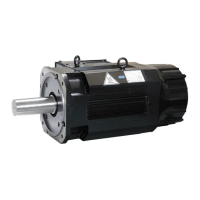6.5 Speed Control
6.5.4 Zero Clamping
6-24
6.5.4
Zero Clamping
Zero clamping is used to lock the servo when the input voltage of the V-REF (Speed Reference
Input) signal is equal to or lower than the speed set for the zero clamping level (Pn501 or
Pn580) while the /ZCLAMP (Zero Clamping) signal is ON. The SERVOPACK internally forms a
position loop, ignoring the speed reference.
Zero clamping is used for speed control in systems in which the host controller does not form a
position loop.
The Servomotor is clamped within one pulse of the position where zero clamping was applied,
and will return to the zero clamping position even if it is moved by an external force.
Adjust Pn102 (Position Loop Gain) if the Servomotor oscillates during zero clamping. If gain
selection is used, you must also adjust Pn106 (Second Position Loop Gain).
/ZCLAMP (Zero Clamping) Signal
Use the /ZCLAMP signal to enable zero clamping.
When Using the Default Input Signal Allocations (Pn50A = n.0)
The /ZCLAMP signal is allocated to pin CN1-41 on the I/O signal connector by default.
Typ e Signal Connector Pin No. Signal Status Meaning
Input /ZCLAMP CN1-41
ON (closed)
Zero clamping is applied if the input voltage of the
V-REF (Speed Reference Input) signal is equal to or
lower than the speed set for the zero clamping level
(Pn501 or Pn580).
OFF (open) Zero clamping is disabled.
Held in
place.
/ZCLAMP (Zero
Clamping) signal
V-REF (Speed
Reference Input)
Signal
Host
controller
SERVOPACK
/ZCLAMP
(Zero Clamping) signal
Released
AppliedReleased
Applied
ON OFF
Time
Zero clamping
Zero clamping level
(setting of Pn501 or
Pn580)
Speed
V-REF (Speed Reference Input) signal

